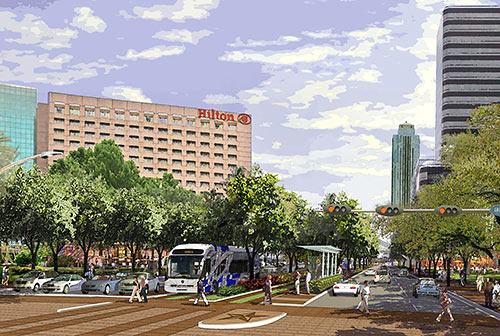So says this op-ed.
Always susceptible to gridlock, especially at Christmastime, the traffic jams now happen year-round and last longer each day. Clearly, Uptown badly needs convenient, reliable alternatives to cars for the tens of thousands of workers and residents who live, work and shop in the area, the largest business district in the nation outside of a traditional downtown.
One such alternative is bicycling. Houston has made impressive progress in recent years to make bicycling safer and more convenient.
The Bayou Greenways Initiative, Safe Passing Law and Complete Streets policy are recent examples, and an updated Bikeway Master Plan, now underway, will identify additional on- and off-street facilities to fill in the gaps in Houston’s bikeway network.
Uptown, however, remains dangerous to navigate by bike, especially during rush hour. Surrounded on three sides by major freeways, there are few safe options to enter the area by bike. Once there, a cyclist must navigate streets designed solely to move cars as quickly as possible, with few accommodations for cyclists. Post Oak Boulevard, Uptown’s signature street, is an obvious example. While biking there can be a death-defying experience, even walking is a daunting and frightening prospect, with sidewalks located right next to speeding traffic.
The proposed Uptown dedicated bus lanes project (“Bus project along Post Oak appears ready to roll ahead” Page B3, Jan. 29) will provide one alternative to driving, especially for commuters in the suburbs who have access to park and ride routes that run to the existing Northwest and proposed Bellaire/Uptown transit centers. The project features a total rebuild of Post Oak Boulevard to add dedicated bus lanes in the middle, while preserving existing lanes for cars.
Unfortunately, the plan as currently proposed includes no bike lanes, and maintains wide, high-speed main traffic lanes. Thus, while it will provide an alternative to driving for suburban commuters, the current dedicated bus lane plan does nothing for Uptown workers who live close enough to bike to work, but who won’t risk their lives (and their families’ livelihoods) to do so. It also does little for local residents who might like to bike to local shops and restaurants or into adjoining neighborhoods and parks, including Memorial Park (now a part of the Uptown tax increment reinvestment zone.)
Adding dedicated bike lanes to the dedicated bus lane project would provide an additional alternative to those who want access to shops, workplaces and restaurants along Post Oak, as well as provide connectivity to adjoining neighborhoods, Memorial Park and the Greater Houston bikeway network.
Bike lanes would also enhance the pedestrian realm by providing a buffer between sidewalks and automobile traffic.
I agree completely. It doesn’t make sense to spend all that money redoing Post Oak Lane and not end up with a street that is more bike and pedestrian friendly. There are two ways to deal with excessive traffic in destinations like Uptown: Make it easier to get there without driving, primarily for commuters, and make it easier for those who are already there to get around within the area without driving. Downtown does both of those things. Uptown is working on the first one, with the BRT line and the HOV lane. It really needs to do the other, and the opportunity to do that begins with the BRT line construction on Post Oak. I want to be clear that this is the Uptown Management District’s responsibility. Metro will operate the BRT line once it is built, but the Management District is doing the design and construction. Please do it right the first time, y’all.

